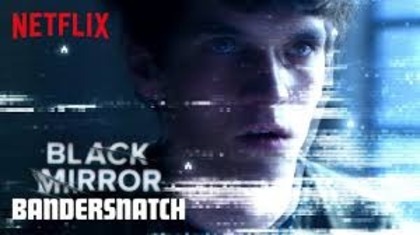REVIEW: Netflix's "Black Mirror: Bandersnatch"
 Sunday, December 30, 2018 at 12:53 PM by
Sunday, December 30, 2018 at 12:53 PM by  Nick DeMartino
Nick DeMartino <This review contains spoilers>
As somebody who has been looking at the coming of interactive storytelling as the “next big thing” for more than 20 years, Netflix’s release of “Bandersnatch” interactive movie from Charlie Brooker’s ‘Black Mirror’ team was cause for cautious celebration. Here for once we would have a major global media/tech brand willing to commit its credibility, technical team, and an IP crown jewel to an interactive story outside the formal videogame format. For years I railed that Netflix, Hulu, Prime and the other OTT providers offered less inventive ancillary content than DVDs and even less experimentation than cable, that much-maligned dinosaur.
 Alas, my enthusiasm wilted, when leaks indicated that Netflix’s story format would rely upon the “choose your own adventure” trope – basically a branched narrative. Many have tried and failed with this warhorse from our childhoods. When Bandersnatch’s first user choice was the protagonists’ breakfast cereal, I was positively morose. Here we go again, I thought. Nevertheless, I persisted, and I’m glad I did. Very quickly it was clear that choices were consequential to the plot, forcing choices between two unappealing options. Sometimes, it seemed, my choice wasn’t the “right” choice, and the app performed its own form of reboot—a bit like those “previously on,,,” montages that we’re used to seeing at the beginning of a new episode. Sometimes when this happened, I was presented with the same two options, sometimes the choices were different. I’ve read that the story had five different endings and very large number of plot permutations. I found my way to three of the five, each time learning something new about the way the system worked. Overall, I’d give this one three out of five stars.
Alas, my enthusiasm wilted, when leaks indicated that Netflix’s story format would rely upon the “choose your own adventure” trope – basically a branched narrative. Many have tried and failed with this warhorse from our childhoods. When Bandersnatch’s first user choice was the protagonists’ breakfast cereal, I was positively morose. Here we go again, I thought. Nevertheless, I persisted, and I’m glad I did. Very quickly it was clear that choices were consequential to the plot, forcing choices between two unappealing options. Sometimes, it seemed, my choice wasn’t the “right” choice, and the app performed its own form of reboot—a bit like those “previously on,,,” montages that we’re used to seeing at the beginning of a new episode. Sometimes when this happened, I was presented with the same two options, sometimes the choices were different. I’ve read that the story had five different endings and very large number of plot permutations. I found my way to three of the five, each time learning something new about the way the system worked. Overall, I’d give this one three out of five stars.
The engineers were successful in building an assembly engine that delivers seamless scene integrations with very few exceptions. Ditto with story continuity – the flashbacks or whatever you call them, included visual and audio confirmation of my choices every time. The gameplay (the interaction with the story and the app) is enhanced greatly by the content of this actual story itself, which centers on a young game designer bedeviled by trauma and mental issues as he is building his dream game, the Bandersnatch of the title (HT to Lewis Carroll and later to Philip K. Dick) based on a novel whose author cracked up violently before it could be finished. Boom: Ontogeny recapitulates phylogeny…. Along the way, our hero’s crack-up (or the reality of two parallel universes that can reboot) begins to embrace the actions of the Netflix user herself, which is mildly funny as presented.
Over the years I’ve quipped that interactive stories won’t become mainstream until they make me cry, a glib way of suggesting that the inherent problem with interactive stories is that they simply cannot achieve the dramatic compression, pacing, and narrative immersion of a traditional storyform, since the user is constantly pulled out of the story to do something. Did Bandersnatch overcome this problem? Not really, although the story segments that this app assembled did provide a lot of the same pleasure as other Black Mirror dystopian episodes, and an odd form of suspense was generated as different iterations of the story unfolded, a bit like ‘Groundhog Day.’ Like other Black Mirror entries, in Bandersnatch the characters can’t win, technology is in charge; choice is an illusion, and so forth.
I was left with the conclusion that Black Mirror was a good choice for Netflix to test the backend authoring system given Brooker’s obsession with how tech and culture impact human consciousness. Whether Brooker & company use the platform with more success in the future will be interesting. Ditto as to whether other auteurs give the tech a shot in other story genres such as detectives, espionage, thrillers, action adventure, and even rom-com. (Note: Netflix previously released kids’ content using similar technology.)
Bottom line: Unlike many previous interactive story formats, the embedding of the technology into hundreds of millions of devices already signed up to a story delivery platform is wonderful. Though I had to work a bit to get the thing to work (it would not play via Dish Network; I had to update my Netflix iOS app on my iPad before I could view and play), overall, the results were worthwhile.
 Bandersnatch,
Bandersnatch,  Black Mirror,
Black Mirror,  Netflix in
Netflix in  2018,
2018,  Media,
Media,  design,
design,  games,
games,  innovation,
innovation,  movies,
movies,  storytelling,
storytelling,  technology,
technology,  television
television  Print Article
Print Article 
Reader Comments